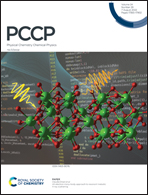First-principles prediction on antimony-doping effects on the cyclic stability of tin anodes for lithium-ion batteries
Abstract
Tin-based materials are considered as promising anode materials for advanced Li-ion batteries (LIBs) due to their relatively high capacity and suitable working voltage, but they suffer from poor structural stability during electrochemical cycling. Herein, we present the possibility that the cyclic stability of the Sn LIB anode can be enhanced by adding a small amount of antimony (Sb), based on first-principles investigation of lithiation behavior of amorphous Sn doped with 3 at% Sb. At low Li contents (x < 1.5 in a-LixSn0.97Sb0.03), our simulations show that the preferential reaction of Li with Sb over Sn tends to lead to the formation of small lithiated Sb clusters. However, the aggregated Sb, if any, become fully separated upon further lithiation, implying that they may remain well dispersed in the lithiation/delithiation process if the Sb-doping concentration is sufficiently low. The weak aggregation and preferential lithiation tendency of Sb in the Sb-doped Sn anode can be expected to contribute to enhancing its structural stability during cycling, in comparison with pure Sn and SnSb alloy cases. We also compare lithiation-induced changes in the electrochemical, transport and mechanical properties between the Sb-doped and pure Sn systems. Our study highlights the importance of low concentration and uniform distribution of Sb in order to obtain desired properties of Sb-doped Sn as an anode for LIBs. This finding also provides some hints for the further development of Sn-based anodes via fine-tuning of doping.



 Please wait while we load your content...
Please wait while we load your content...